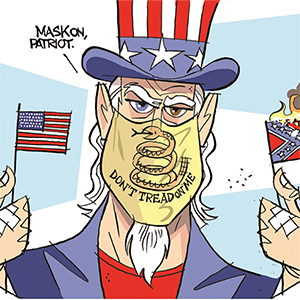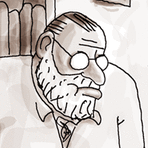Science & Technology
/Knowledge

Mountain lion cub shows promising recovery after he was badly injured in Orange County
A mountain lion cub left with a skull fracture and severe head and eye trauma after being struck by a car in Orange County earlier this year has made a sharp recovery and could soon return to the wild, the San Diego Humane Society announced on Saturday, Apr. 5.
The male cub was roughly four months old when he was found on the side of an Orange ...Read more

Hikers beware: A rash-causing plant is growing in fire-scarred Angeles National Forest
LOS ANGELES — A beautiful menace is growing on the freshly charred slopes of the San Gabriel Mountains.
The whimsically named poodle-dog bush thrives in the wake of fires, such as the more than 14,000-acre Eaton fire that ravaged swaths of the Angeles National Forest in January. The mountain shrub strikes the senses with bell-shaped purple ...Read more

Trump is gutting the nation's environmental programs. Here's what it will cost Americans
LOS ANGELES — The Trump administration’s slash-and-burn approach to federal programs has delivered a considerable hit to the nation’s environment, but experts say its plans to repeal hard-won protections for clean air and water will also directly jeopardize Americans’ health — and their wallets.
Two new reports from environmental ...Read more

SpaceX's private polar space trip returns to Earth
The four crew members of the private Fram2 mission returned to Earth on Friday after spending more than 3 1/2 days circling the planet on the first human spaceflight on a polar orbit.
The SpaceX Crew Dragon Resilience made a parachute-assisted splashdown off the California coast at 9:19 a.m. Pacific time. The mission launched from Florida's ...Read more

Private polar space trip set to return to Earth today
SpaceX is set to return to Earth today the four crew of the private polar Fram2 mission that launched from Kennedy Space Center on Monday night.
The Crew Dragon Resilience is targeting splashdown off the California coast at 12:19 p.m. EDT (9:19 a.m. PDT) after spending more than 3 1/2 days circling the planet on the first human spaceflight on a...Read more

More water recycling could help fix Colorado River shortfall. California has a ways to go, report says
LOS ANGELES -- California isn’t recycling nearly enough water, according to a new report by UCLA researchers, who say the state should treat and reuse more wastewater to help address the Colorado River’s chronic shortages.
Analyzing data for large sewage treatment plants in seven states that rely on Colorado River water, the researchers ...Read more

5 major takeaways from the Nintendo Switch 2 announcement
Nintendo just placed on its cards on the table when it comes to its upcoming console, the Nintendo Switch 2.
The company showed off new features that highlight more connectivity, higher computer horsepower and an army of games coming to a system that’s launching June 5, 2025.
Here are the most important details from the presentation and ...Read more

California announces plans to relax protections for wolves as population grows
In the latest sign that wolves are continuing to make a comeback across California after being hunted out of existence for nearly a century, state wildlife officials have announced that population numbers have increased enough that they plan to relax rules that have set strict protections on the high-profile species.
The state Department of ...Read more

On water recycling, Nevada is leagues ahead of other states, study shows
LAS VEGAS — When it comes to recycling the most precious resource in the Colorado River Basin, Nevada blows the other six states out of the water, a new report has confirmed.
Researchers from the University of California, Los Angeles, combed through often-inaccessible wastewater data to show that Nevada leads the seven states with a rate of ...Read more
As the environmental justice ordinance nears introduction at Chicago City Hall, activists express hope and frustration
CHICAGO — More than a year after its planned introduction, an environmental ordinance that aims to address decades of discriminatory planning, zoning and land-use policies in Chicago will finally be brought before the City Council.
But some community activists are blasting city officials for not making the ordinance available to the public ...Read more

Why forecasting where tornadoes will hit is still hard to do − even though storm predictions are improving
Meteorologists began warning that extremely dangerous storms were likely coming days before tornadoes tore across the Central and Eastern U.S. in March and April 2025. But pinpointing exactly where a tornado will touch down still relies heavily on seeing the storms developing on radar. Chris Nowotarski, an atmospheric scientist, explains why,...Read more

Qualcomm acquires Vietnamese AI startup MovianAI
Qualcomm, the San Diego-based company designing chips that power smartphones, laptops, virtual reality headsets and next-generation cars, acquired a Vietnamese startup for its generative artificial intelligence technology.
The local firm announced the acquisition Tuesday as part of its effort to expand its research and development of generative...Read more

As Trump dismantles EPA, Great Lakes states with a history of pollution likely will suffer
CHICAGO — Dirty air remains a chronic problem in the Chicago area.
Shortly before President Joe Biden left office, the U.S. Environmental Protection Agency reclassified the region from “moderate” to “serious” violations of federal regulations limiting lung-damaging smog, also known as ground-level ozone.
Better understanding about ...Read more

Climate disasters are on the rise. These states want to make oil companies pay
For many California residents, the Los Angeles wildfires earlier this year were the latest and most searing example of the devastating effects of climate change. Some estimates have pegged the damages and economic losses from the fires at more than $250 billion.
“We’ve had disaster after disaster after disaster,” said Assemblymember Dawn ...Read more

Apple production hubs hit by tariffs, sending shares plummeting
Apple Inc. is finding itself squarely in the crosshairs of President Donald Trump’s new tariffs, even after a yearslong effort to insulate the iPhone maker from trade wars and supply chain disruptions.
A long list of levies unveiled by the White House are poised to hit the company especially hard, triggering an after-hours stock rout on ...Read more

United Launch Alliance, Amazon set first launch for SpaceX Starlink competitor Project Kuiper
A launch date is set for the first batch of what will be thousands of satellites for Amazon’s Project Kuiper as the company looks to play catch-up to SpaceX and its Starlink internet constellation.
United Launch Alliance is targeting a three-hour window that opens at noon Eastern time on April 9. It will send up 27 satellites on an Atlas V ...Read more

1st day in space filled with nausea for SpaceX's private polar mission crew
The four private space travelers flying around the Earth’s poles this week had a vomit-filled first day in space, according to the man paying for the trip.
“The first few hours in microgravity weren’t exactly comfortable,” Chun Wang, a Chinese-born cryptocurrency entrepreneur said in a Fram2 mission update on X. “Space motion sickness...Read more

An AI 'gold rush.' What to know about OpenAI's record $40 billion funding round
SAN FRANCISCO — ChatGPT maker OpenAI this week announced it raised a whopping $40 billion as it races to dominate a competitive AI landscape against tech giants like Google, and rivals including Anthropic and Chinese upstart DeepSeek.
The investment was the highest ever raised for a startup and places OpenAI at a $300 billion valuation, ...Read more

Tech review: M4 MacBook Air is easy to love
Apple’s new MacBook Air has been recently updated to the M4 processor, and while the design remains the same as the M2 and M3 models before it, there are a few nice upgrades on the inside to make the M4 worthy of your consideration.
Personally, I’ve been a MacBook Pro user at home for decades. I always just thought I needed the most ...Read more

For the first time in 25 years, California has a snowpack trifecta
LOS ANGELES — The year may have started with a dry spell, but the end of California’s storm season has brought more fresh snow to the Sierra Nevada, pushing the state’s snowpack to 96% of average on April 1, when the snow season typically reaches its peak.
The near-average snowpack has given the state a third straight year of ample water ...Read more
Popular Stories
- More water recycling could help fix Colorado River shortfall. California has a ways to go, report says
- Hikers beware: A rash-causing plant is growing in fire-scarred Angeles National Forest
- Mountain lion cub shows promising recovery after he was badly injured in Orange County
- Trump is gutting the nation's environmental programs. Here's what it will cost Americans
- SpaceX's private polar space trip returns to Earth





